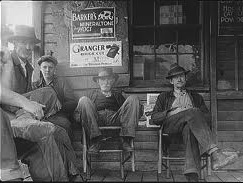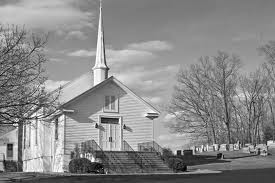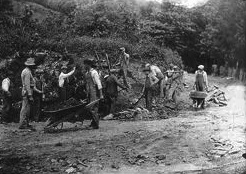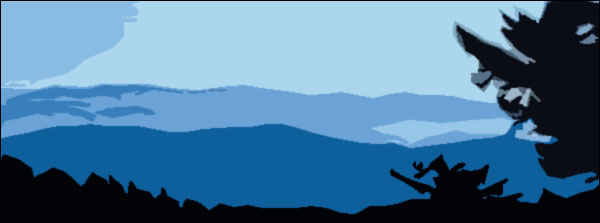An Overview of Deep Gap, NC & US Hwy 421
“Located as they are on the Eastern Continental Divide, Deep Gap and other areas of eastern Watauga County find themselves a melting point of weather patterns, and the melting pot frequently boils over into days and days and nights and nights of dense fog. The fog comes in billows that darken the daylight landscape to a grey murkiness, but at night they become virtually impenetrable curtains. The grayness and opacity thus created become the stuff of legends or hair-raising tales, depending on the storyteller’s art.” John Idol, in “Deep Gap Days: A Crazy-Quilt Narrative of My Boyhood in the Blue Ridge Mountains,” the book from which these columns are excerpted.
Out to Pastoral
by John Idol

BURLINGTON North Carolina—(Weekly Hubris)—5/21/12—The Deep Gap of the time I write was home to a few farmers, perhaps four or five of them owning enough property to work the land full-time, a good many part-time farmers, who found jobs as carpenters and construction workers in Boone or some other nearby town. Among these full-and part-time farmers lived an owner of a garage and country store and families, the Moretzes and Nicholses, who made a living in lumber and building supplies, though, they too, worked the land by keeping gardens and nurturing pastures for cattle.
If a demographer looked closely at family names in Deep Gap and ranged back to the time of my childhood and youth, the tendered report would likely read: “Deep Gap’s families come from European stock—English, Scots, German, Welch. Their surnames are Greene, Watson, Idol, Greer, Moretz, Wilcox, Nichols, Hampton, Miller, Steelman, Hamby, Blackburn, Wellborn, Fairchild, Lookabill, Norris, Welch, Rogers, Coffey, Carroll, Westenheimer, Ray, Clawson, and Simms. No family of African origin lives among them.”
Few people in Deep Gap lack blood ties, for Greenes, Watsons, Greers, Millers, Moretzes, intermarried, cousin hitching to cousin, a few as close as second cousins, some more distant. And most of them belonged to a Baptist church, the exception being Moretzes, whose worship led them to a small Lutheran church located where a road (now US 221) branched off US 421 and led to West Jefferson. The Baptist, Laurel Springs (just off US 421, had as one of its founders my paternal great grandmother, Thirza Greene Idol, a Victorian-looking photograph of whom overlooks me as I write these words.
She looks stern and unforgiving and would, no doubt, drop to her knees in prayer for me if she could read the essay coming at the end of this book. Her hair pulled close to her head, and probably twisted into a bun in back, is parted in the middle on top. Her dress appears to have been black, with a high collar almost touching her square chin. A small pin, fastened aslant, holds the collar together. She looks rigidly righteous in the portrait, but I must consider that formal photographs of the day were not too far removed from tintypes and that she’d been told to sit perfectly still.
I hope she had laughter in her heart and smiles on her lips.
She may well have had if the jollity of her first son, Joseph, as reflected in his letters, was passed down. But she may have been the model of solemnity for her second son, Rufus, my grandfather. A man of few smiles and fewer chuckles, he epitomized Victorian earnestness. A life of subsistence farming leaves little room for gaiety and prompts high expectations of heavenly rewards.
I dwell on this subject because church-life, more than anything else, shaped behavior, beliefs, and aspirations of most of Deep Gap’s residents. Living the Christian life was the supreme goal. Failing to live that life was a mark of shame, the occasion for prayer for the unsaved, the fervent intercession of those committed to bringing the back-slider within the fold again. When the whole of these pages is read, I’ll surely be numbered among the back-sliders.
The steps leading to my apostasy from religion as practiced by my parents, siblings, and neighbors in Deep Gap would, if treated fully and unreservedly, take the form of a spiritual autobiography, the first chapter of which would be close to the final piece in this book. Such an exploration and narration of my spiritual journey has been encouraged by friends who’ve read an early draft of the pages making up the conclusion of this book. Perhaps, one day, I’ll tell the rest of the story.

I justify, in more than one way, the time and effort required to write this book. Through these words I relive many experiences I enjoyed, from which I learned, and through which I formed bonds to my siblings, parents, and neighbors; through these words I catch and freeze moments and events doomed to be forgotten lest I record them, for none of my siblings, relatives, or neighbors have moved from oral to written accounts; through these words I realize, in part, that admonition of the Greeks—“Know thyself.” Here, then, is a kind of verbal archeology, a digging around in the mound of half-buried stuff that refuses to be wholly buried.
A remark often made by people who comment on Southern writing is that Southern authors have a strong sense of place. Though I hesitate to lay claim to being a Southern author—for I have too much respect for the writers of Southern literature to put forward these pages as a finely wrought work of a skilled writer. Here you will find no compelling narrative, no character you will long remember, and no descriptive passages you would cull to send to friends as faithful renderings of Southern Appalachian natural scenes. Yet, there is a sense of place, an awareness of a road, streams, hills, farms, a schoolhouse, and a church.
But more than anything else here is a chronicle of people inhabiting a place, Deep Gap, North Carolina. Here, if I’ve had the talent to pull it off, will become something vaguely akin to the writings of Lee Smith, Fred Chappel, Robert Morgan, and Ron Rash, the abilities of whom brought life to the Southern Appalachia they knew and loved. Here will be Deep Gap as I saw it in my boyhood and youth.
Fixing an Eye on US Highway 421
It hasn’t been celebrated in song nor featured in any renowned novel, as US Highway 66 has. Too bad, because it runs through, or by, legendary places in North Carolina, Tennessee, Virginia, Kentucky, and Indiana, its beginning/ending points being Wilmington, North Carolina, and the shores of Lake Michigan in Indiana. It connects Atlantic fishermen with Blue Ridge foxhunters, Virginia burley tobacco growers, Kentucky coal miners and bourbon masters, and Indiana basketball fanatics. Part of its history is bound up with Daniel Boone and his western trek; part of its glory is found in its passage through the Blue Ridge when rhododendron are blooming; part of its contribution to the making of America was the outlet its forerunners in the form of forest trail or muddy or dusty graveled roads provided for poor Southerners as they sought a better life somewhere in the North or West. It could be a storied road if someone were to travel its entire length, with a side-trip now and then, and combine recorded and oral history with a generous selection of well-chosen photographs.
I’ve often thought of loading up with camera, film, notebook, tape recorders, and good maps and heading out from Wilmington at a leisurely pace, coming at last to the terminal of 421 in Indiana. I’d talk with old-timers and youngsters, stop by schools, colleges, farms, factories, eateries, vineyards, shops, shacks, and McMansions, and report on what I’d found in my travels. I’d hope to suggest that I’d discovered the real America as I met people, learned about their accomplishments and failures, and heard what they thought was right and/or wrong with our nation.
The trip would take months, for I’d want to hear music, from Bluegrass to classical, hymns from shape-note singers and oratorios from college and community choruses, jazz, rock, ballads, folk, fiddlers, and banjo pickers, to mention some of the types I’d surely run into. I’d spend an afternoon with Doc Watson in Deep Gap, my natal place also, admire Kentucky race horses, collect some tales of early stock car races from Junior Johnson, rent a vintage MG to slip through the curvy stretches of 421 in East Tennessee, watch the Colts prepare for an upcoming game, and take in lectures on literature, art, philosophy, astronomy, and politics at some of the several colleges and universities nestled alongside US 421.
I’m likely not to hit the road to do any of these things, much as I’d like to. I could content myself with arm-chair travel and range along the entire length of this uncelebrated highway, taking a kind of virtual journey. Before there was a national highway bearing the nomenclature “421” a narrow, crooked road numbered North Carolina 60 snaked its way from a point northwest of Wilmington to the Tennessee line. NC 60 became part of the federal highway system sometime before 1933-34, according to maps in the archives of the North Carolina Department of Transportation.
To cobble together a southeast to northwest corridor in the Tar Heel state, highway planners linked NC 23 to NC 60 in Pender County and then other state highways, including NC 61 in Harnett County, NC 65 in Forsyth County, NC 18 in Wilkes County, and NC 691 in Watauga.

Long before county, state or federal roads were built, buffalo and other animals trampled a path through woodlands, a path stealthily followed by Cherokee hunters as they pursued their prey. Daniel Boone and other frontier hunters followed the trail blazed by game animals and their Cherokee pursuers.
Not being dumb brutes, the animals chose to spare themselves the hardship of climbing any more rugged terrain than they had to and thus passed through a deep gap in the Blue Ridge on their way out of the foothills to greener pastures on the western slope of the Eastern Continental Divide, Cherokee hunters chasing them, flinging spears, shooting arrows, and dressing their meat before heading back to their campsite. As a child, roaming over the farmland of my Watson grandparents, I found spear points a good ten to twelve inches long and arrow heads almost as sharp as Dad’s straight razor. Many of these I picked up within 50 or so feet of US 421, coming upon them when rain fell on freshly turned soil as spring crept in.
These Cherokee hunters knew that if they posted themselves alongside the trail that game animals followed they’d have targets for their spears and arrows, meat for their families, hides for their clothing and wigwams. If I’d had a collector’s instinct instead of a small lad’s wish to impress Mary Nell Greene, I would have stashed away spear points and arrows and spared myself the frustration of not finding either when I grew old enough to admire the Stone Age skills of those hunters.
Puppy love is fraught with foolishness! I doubt if Mary Nell, wherever she is, remembers the honor I paid her in putting such splendid artifacts in her hands.
One historian suggests that these hunters called their hunting grounds “Watauga,” a Cherokee word said to mean “land of beautiful waters.” The hills of Watauga give rise to the north-flowing New River, which, after much meandering in North Carolina and Virginia, shoots into West Virginia before feeding into the Ohio River and on to the Gulf of Mexico via the Father of Waters, the Mississippi. Also springing up in Watauga is a river of the same name. Its westerly flow takes it into Tennessee and then on to the Mississippi. The Yadkin River, with headwaters elsewhere in the Blue Ridge, draws into itself some of Watauga County’s creeks and branches. US Highway 421 crosses some of the feeder streams of the Yadkin, Watauga, and New River.
One of the feeder streams is named Meadow Creek, which joins Gap Creek on its way to become part of the South Fork of the New. Another feeder stream, its headwaters being several springs on property bought by my great grandfather John Nicholson Idol, bears no name, although I’m inclined to call it Idol Branch, for “branch” was the term Grandfather Rufus used when he spoke of the stream. It reaches about the same volume of water as Meadow Creek before it, too, flows into Gap Creek.
After the Revolutionary War ended and the Blue Ridge was opened to settlement by people of European stock, my maternal and paternal ancestors Thomas Watson and Solomon Greene claimed acreage in the valley formed by Meadow and Gap Creek or on the hillside just east of Gap Creek. The Watson tract was much larger and more fertile. Some of it was what might be called rolling bottomland, for flat fields are rare in the area. The Watson claim was split apart by the ancient trail trod out by animals. It was this trail that, in time, became the bed of US 421.
The Greene claim began in a rocky, steep area to the east of the Watson spread, in an area justly named Stoney Fork, and ran west to a point beyond a gap between two mountains of the Blue Ridge. The ancient trail also split the Greene property.
Beside the trail, Solomon felled trees and hewed and notched them into a log cabin, barn, and a small smithy. A mile or more west of him, the Watson clan built houses alongside the trail, one of the Watsons constructing a grist mill to make use of the ample flow of Meadow Creek. Among the many children of Lee Parks Watson and his wife, Emmaline Hodges, were twins, John and Jeremiah (Jerry).
They each built houses along opposite sides of the trail, some 500 yards apart, and then, just across the trail from where Jerry built a two-story house with a lean-to serving as space for cooking and dining, they threw up a small country store, becoming merchants while continuing to farm the land they had inherited. Much modified over the years, the building still stands, though it ceased being a store not long after Jerry’s death. (John had sold out to Jerry and moved his family to Coshocton, Ohio, where better farmland was available.)
It was in the Jerry Watson house that I was born (10/28/1932) and lived until my fifth year. Also born there were brothers Jack, Jim, and Bill. When my father could at last afford to put up a house on the land that Jerry’s daughter Annie received as her portion of her father’s estate, he built it farther back from the ancient trail, now sporting signs of US 421 after wearing the label NC 60 for many years. The driveway was over a hundred yards long and virtually impassable in rainy or snowy weather. Fieldstones gathered by my brothers and me helped only to make passage over the road rougher. When gravel was at last spread over the rocks, the drive from 421 was smooth and easy, except in winter when snow drifted in behind the slope on the upper side. Sometimes snow piled up to depths of two or more feet and had to be shoveled or plowed aside.
Lane’s house had just four rooms, two of them bedrooms, one a combination living room-bedroom, and a kitchen. For several years, one bedroom, furnished with two beds, served as sleeping quarters for four sons, two to a bed. When Bob joined the family, Lane and Annie gave up their bedroom and placed their bed in a corner of the living room. Crowded to begin with, with its couch, chairs, and wood-burning stove, it gave them little privacy, for their sons had to pass through it on their way to the outhouse. The arrival of a daughter, Joyce, stirred Lane to action: he added a third bedroom, a large one meant to serve as a dormitory for his sons. In this room, three or four beds were set up. Joyce had her own space and Lane and Annie reclaimed their bedroom.
The sleeping arrangement in the Idol house was similar to that of other large families in Deep Gap occupying four-room houses.
. . . to be continued.


3 Comments
Sandra Kay
How much do the books cost?
Sandra Kay
I went to school with Joyce. And loved her dearly.
Susan Greene Griesme
We are direct decendentsf Solomon Greene. My father was in the flood of 1940 where he lost his father and sisters.